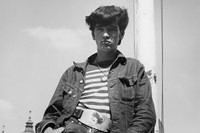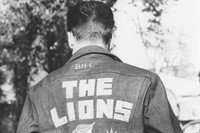Swiss photographer Karlheinz Weinberger worked in virtual mild-mannered obscurity in the warehouse department of a factory in Zurich for most of his life, only getting the opportunity to indulge in his favorite past time, taking pictures, during his
Swiss photographer Karlheinz Weinberger worked in virtual mild-mannered obscurity in the warehouse department of a factory in Zurich for most of his life, only getting the opportunity to indulge in his favourite past time, taking pictures, during his off hours. Over the last decade those gritty images of stylishly disaffected, denim clad young people, Elvis Presley-obsessed street gangs and Switzerland’s version of the Hell’s Angels, shot by Weinberger mainly in the 50s, 60s and 70s, have finally become much more known. After several shows in Europe and New York, Weinberger’s work is now coveted by art collectors and his, as well as his subjects’, aesthetic have become a great inspiration, influencing everything from Versace campaigns to the jeans and oversized belt buckles worn by many today. Picking up on the Weinberger zeitgeist, this month Rizzoli is publishing Rebel Youth, a second book of Weinberger photographs featuring 142 never-before-published photographs (the first, published in 2000 has become a hard-to-find collectors item) and two shows of Weinberger’s work will go on view soon in New York. Beginning 11 February, Anna Kustera Gallery will show, for the first time, colour images printed since Weinberger’s death in 2006. Intimate Stranger, an exhibition of Weinberger’s vintage prints, curated by Gianni Jetzer, opens tomorrow at the Swiss Institute. AnOther recently spoke with Jetzer about Weinberger.
What is the story behind Karlheinz Weinberger and his photographs?
Weinberger was totally fascinated with photography. From the day he received his first camera at a very young age, which was given to him by a lover, he felt the urge to take pictures. Although he had a day job as warehouseman and never really made money with his shots, he maintained this passion until the end of his life. Under the pseudonym Jim he began, in the mid 50s, to publish portraits in a gay magazine. Most of them were taken whilst travelling in Southern Italy. In 1958, he met a young rocker named Jimmy Oechslin in the streets of Zurich and asked him, excitedly, if he could take his portrait. Through him he was introduced to the burgeoning gang culture in Switzerland. Teenagers under the influence of American culture celebrated their own lifestyle by wearing customised jeans and by riding motorcycles. Eventually, in the 80s and 90s, Weinberger went on to photograph the Hell’s Angels in Switzerland.
How would you describe Weinberger’s aesthetic?
Rough, personal, artistic. He was at times very commanding during photo shoots and had an almost ethnographic interest in gangs and biker culture. At times, a buckle belt was more important than a face. Through his passion for photography he was part of gangs without adopting their lifestyle.
Who are the people in these images?
In Germany and Switzerland the German term 'Halbstarker' was created in the 50s. It literally means half strong. The 'half strongs' were gangs of young people who were looking for an identity of their own. They rejected society’s expectation and were pioneers in the establishment of youth culture through music, cloths and assimilation of American culture.
You’ve curated the first institutional exhibition of Weinberger’s work. What makes these images so resonant today?
The first institutional exhibition was in 2000 at the Design Museum in Zurich. Intimate Stranger is the first show that consists exclusively of vintage prints. Weinberger developed most of them in his home lab and was almost amateurish while enlarging, leaving dust particles on negatives. Some of them are even scratched, which didn’t seem to bother him at all. This seems very un-Swiss. You can sense his obsession with the subject and his impatience to discover an image. I guess that he must have had an almost feverish relationship with these prints.
The show is called Intimate Stranger. Could you explain why you chose this title?
The title reflects the position of Weinberger as an outsider within the gangs of Halbstarke. He got really close without being part of them. Photography was his access to a world that would have been otherwise inaccessible for him. He was therefore an intimate stranger.
Text by Ricky Lee
Intimate Stranger opens at the Swiss Institute on 8 February. Karlheinz Weinberger: Halbstarke to Bikers: In Color opens at Anna Kustera Gallery on 11 February.



